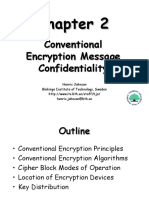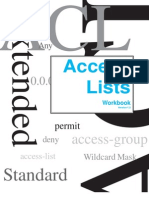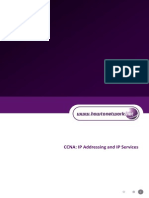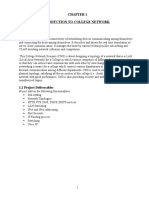Subnetting Exercises Answers
Subnetting Exercises Answers
Uploaded by
Zekarias HailuCopyright:
Available Formats
Subnetting Exercises Answers
Subnetting Exercises Answers
Uploaded by
Zekarias HailuCopyright
Available Formats
Share this document
Did you find this document useful?
Is this content inappropriate?
Copyright:
Available Formats
Subnetting Exercises Answers
Subnetting Exercises Answers
Uploaded by
Zekarias HailuCopyright:
Available Formats
Subnetting Exercises Answers v1.
10 Aaron Balchunas
- Subnetting Exercises Answers (Please note: For all subnetting questions, assume the all-zeroes and all-ones subnets are usable. Or, in the Cisco vernacular, assume we have ip subnet-zero enabled.)
1.
Convert the following decimal numbers to binary. 100: 01100100 254: 11111110 113: 01110001 66: 01000010
2.
Convert the following binary numbers to decimal. 10101010: 00011100: 11101110: 01100111: 170 28 238 103
3.
You have the following address: 192.16.5.133/29 How many total bits are being used to identify the network, and how many total bits identify the host? 29 bits identify the network, 3 bits identify the host.
4.
What is the full subnet mask for address 172.16.5.10/28? 255.255.255.240
*** All original material copyright 2006 by Aaron Balchunas (aaron@routeralley.com), unless otherwise noted. All other material copyright of their respective owners. This material may be copied and used freely, but may not be altered or sold without the expressed written consent of the owner of the above copyright. Updated material may be found at http://www.routeralley.com.
Subnetting Exercises Answers v1.10 Aaron Balchunas
5.
You currently use the default mask for your IP network 192.168.1.0. You need to subnet your network so that you have 30 additional networks, and 4 hosts per network. Is this possible, and what subnet mask should you use?
Yes it is possible, using subnet mask 255.255.255.248.
6.
You still are using the default mask for your IP network 192.168.1.0. You need to subnet your network so that you have 5 additional networks, and 60 hosts per network. Is this possible, and what subnet mask should you use?
No, it is not possible.
7.
You have sub-netted your class C network 192.168.1.0 with a subnet mask of 255.255.255.240. Please list the following: number of networks, number of hosts per network, the full range of the first three networks, and the usable address range from those first three networks. Number of networks = 16 Number of hosts = 14 Full Range for first three networks: 192.168.1.0-15 192.168.1.16-31 192.168.1.32-47 192.168.1.1-14 192.168.1.17-30 192.168.1.33-46
Usable Range for first three networks:
*** All original material copyright 2006 by Aaron Balchunas (aaron@routeralley.com), unless otherwise noted. All other material copyright of their respective owners. This material may be copied and used freely, but may not be altered or sold without the expressed written consent of the owner of the above copyright. Updated material may be found at http://www.routeralley.com.
Subnetting Exercises Answers v1.10 Aaron Balchunas
8.
You have sub-netted your class C network 200.138.1.0 with a subnet mask of 255.255.255.252. Please list the following: number of networks, number of hosts per network, the full range of the first three networks, and the usable address range from those first three networks. Additionally, identify the broadcast addresses for each network. Number of networks = 64 Number of hosts = 2 Full Range for first three networks: 200.138.1.0-3 200.138.1.4-7 200.138.1.8-11 200.138.1.1-2 200.138.1.5-6 200.138.1.9-10 200.138.1.3 200.138.1.7 200.138.1.11
Usable Range for first three networks:
Broadcast Addresses for first three networks:
*** All original material copyright 2006 by Aaron Balchunas (aaron@routeralley.com), unless otherwise noted. All other material copyright of their respective owners. This material may be copied and used freely, but may not be altered or sold without the expressed written consent of the owner of the above copyright. Updated material may be found at http://www.routeralley.com.
You might also like
- 7.1.4.9 Lab - Identifying IPv4 AddressesDocument3 pages7.1.4.9 Lab - Identifying IPv4 AddressesEduardo Haro38% (16)
- Lab - Calculate Ipv4 Subnets: ObjectivesDocument4 pagesLab - Calculate Ipv4 Subnets: ObjectivesJad Abou ZeidNo ratings yet
- Client Server Architecture A Complete Guide - 2020 EditionFrom EverandClient Server Architecture A Complete Guide - 2020 EditionNo ratings yet
- Ip AddressingDocument7 pagesIp AddressingDanial RichardsNo ratings yet
- Network with Practical Labs Configuration: Step by Step configuration of Router and Switch configurationFrom EverandNetwork with Practical Labs Configuration: Step by Step configuration of Router and Switch configurationNo ratings yet
- WAN TECHNOLOGY FRAME-RELAY: An Expert's Handbook of Navigating Frame Relay NetworksFrom EverandWAN TECHNOLOGY FRAME-RELAY: An Expert's Handbook of Navigating Frame Relay NetworksNo ratings yet
- CISCO PACKET TRACER LABS: Best practice of configuring or troubleshooting NetworkFrom EverandCISCO PACKET TRACER LABS: Best practice of configuring or troubleshooting NetworkNo ratings yet
- Subnetting Practice B2Document4 pagesSubnetting Practice B2mjrbacon100% (6)
- Topology (Network Design) : White White White White White White White WhiteDocument43 pagesTopology (Network Design) : White White White White White White White WhiteMohsin AhmadNo ratings yet
- IP SubnettingDocument12 pagesIP SubnettingFrater SurgamNo ratings yet
- SubnettingDocument16 pagesSubnettingVishal Jain100% (1)
- IP Addressing and Subnetting: ExercisesDocument10 pagesIP Addressing and Subnetting: ExercisesKastuv Mani TuladharNo ratings yet
- Module 12: Ipv6 Addressing: Introduction To Networks V7.0 (Itn)Document52 pagesModule 12: Ipv6 Addressing: Introduction To Networks V7.0 (Itn)thanh vienNo ratings yet
- IP Addressing, Subnetting, SupernettingDocument65 pagesIP Addressing, Subnetting, SupernettingFiroz kumarNo ratings yet
- Cisco Packet Tracer ProjectDocument23 pagesCisco Packet Tracer ProjectVignesh RamanathanNo ratings yet
- Subnetting: Subnet MaskDocument48 pagesSubnetting: Subnet MaskIct lab100% (1)
- Subnetting ProblemsDocument17 pagesSubnetting ProblemsVishwa SinghNo ratings yet
- Conventional Encryption Message ConfidentialityDocument26 pagesConventional Encryption Message Confidentialityishita chakrabortyNo ratings yet
- Simple Network Design With DNS Servers in Packet Tracer - Madhav PaudelDocument12 pagesSimple Network Design With DNS Servers in Packet Tracer - Madhav PaudelAshu GiriNo ratings yet
- VLSM (Variable Length Subnet Mask)Document11 pagesVLSM (Variable Length Subnet Mask)Afrin Akter Mim 191-15-12862No ratings yet
- IP Addressing & Subnetting: Engr. Carlo Ferdinand C. Calma, CCNADocument15 pagesIP Addressing & Subnetting: Engr. Carlo Ferdinand C. Calma, CCNACarloNo ratings yet
- Linked List, Stack, QueueDocument13 pagesLinked List, Stack, QueueTaqi IsmailNo ratings yet
- Subnetting Made EasyDocument4 pagesSubnetting Made Easyfuhrer232842No ratings yet
- Module1-Introduction To NetworkDocument14 pagesModule1-Introduction To NetworkUsop AbdullahNo ratings yet
- Ccna SubnettingDocument6 pagesCcna SubnettingSrimannarayanaJamiliNo ratings yet
- MultiplexingDocument47 pagesMultiplexinglvsaruNo ratings yet
- IP Addressing and SubnettingDocument7 pagesIP Addressing and SubnettingMalikMohsin0% (1)
- IP Addresses and SubnettingDocument16 pagesIP Addresses and SubnettingHusnainNo ratings yet
- IPv4 AddressingDocument21 pagesIPv4 AddressingMIHAYA MNo ratings yet
- CCNA Summary Notes: Spanning Tree Protocol (802.1D)Document32 pagesCCNA Summary Notes: Spanning Tree Protocol (802.1D)segrelNo ratings yet
- IPv6 and Packet TracerDocument98 pagesIPv6 and Packet TracerNguyễn Trọng HùngNo ratings yet
- 2013fall Sloa Cnet155a Skillsexam PDFDocument10 pages2013fall Sloa Cnet155a Skillsexam PDFkerehore63No ratings yet
- VLSM Addressing: Problem 1Document9 pagesVLSM Addressing: Problem 1ABDUL HADI KHANNo ratings yet
- CISCO Access Lists Workbook Student Version 1.2Document69 pagesCISCO Access Lists Workbook Student Version 1.2Krystal MeethNo ratings yet
- Ip Addressing & Subnetting WorkbookDocument86 pagesIp Addressing & Subnetting WorkbookahmadNo ratings yet
- Subnetting 300+ ExercisesDocument34 pagesSubnetting 300+ Exerciseskevin gwenhure100% (1)
- IP Address Classes and RangesDocument6 pagesIP Address Classes and RangesIan OffemariaNo ratings yet
- Fazer 5.3.2.4 Lab - Troubleshooting Inter-VLAN Routing PDFDocument8 pagesFazer 5.3.2.4 Lab - Troubleshooting Inter-VLAN Routing PDFEder MonteiroNo ratings yet
- Fundamentals of Wireless LANs Answer - 100%Document8 pagesFundamentals of Wireless LANs Answer - 100%John van der VaartNo ratings yet
- Variable Length Subnet Mask (VLSM)Document22 pagesVariable Length Subnet Mask (VLSM)Jeyanthi GovindasamyNo ratings yet
- Network Layer: Logical AddressingDocument64 pagesNetwork Layer: Logical AddressingDEEPALI BAGULNo ratings yet
- Question Bank Unit 4 - 5 - 6Document7 pagesQuestion Bank Unit 4 - 5 - 6Piyush TembhurneNo ratings yet
- LANDocument38 pagesLANDenise NelsonNo ratings yet
- Computer Laboratory Manual: Parallel and Distributed ComputingDocument65 pagesComputer Laboratory Manual: Parallel and Distributed Computingmisss123No ratings yet
- CCNA IP Addressing VLSM Cheat SheetDocument4 pagesCCNA IP Addressing VLSM Cheat Sheetkayciofgv100% (1)
- Ccna TestDocument30 pagesCcna TestHoang Minh LamNo ratings yet
- 9.3.2.13 Lab - Configuring and Verifying Extended ACLsDocument8 pages9.3.2.13 Lab - Configuring and Verifying Extended ACLsAnonymous cW6o4f886% (14)
- Project Report 1Document46 pagesProject Report 1archit garg100% (1)
- Lab Exercise: SubnettingDocument27 pagesLab Exercise: SubnettingMahmmoud MahdiNo ratings yet
- 8.1.4.8 Lab - Designing and Implementing A Subnetted IPv4 Addressing SchemeDocument7 pages8.1.4.8 Lab - Designing and Implementing A Subnetted IPv4 Addressing SchemeRYanNo ratings yet
- 6 Block Cipher CryptosystemsDocument53 pages6 Block Cipher CryptosystemsHasan BadirNo ratings yet
- Network Management System A Complete Guide - 2020 EditionFrom EverandNetwork Management System A Complete Guide - 2020 EditionRating: 5 out of 5 stars5/5 (1)
- 7 IPSubnettingDocument26 pages7 IPSubnettingwebsnapNo ratings yet
- Subnetting Exercises: Total Bits Are Being Used To Identify The Network, and How Many Total Bits Identify The Host?Document4 pagesSubnetting Exercises: Total Bits Are Being Used To Identify The Network, and How Many Total Bits Identify The Host?Hermann BrouNo ratings yet
- Address Classes: N Red NNNNNNNN NNNNNNNN NNNNNNNN NNNNNNNN NNNNNNNN NNNNNNNNDocument9 pagesAddress Classes: N Red NNNNNNNN NNNNNNNN NNNNNNNN NNNNNNNN NNNNNNNN NNNNNNNNDenaiya Watton LeehNo ratings yet
- IP Address Sub Netting TutorialDocument9 pagesIP Address Sub Netting TutorialTaukettNo ratings yet
- What Is An IP AddressDocument6 pagesWhat Is An IP AddressAung ZinNo ratings yet
- IP AddressingDocument8 pagesIP AddressingtombekinNo ratings yet
- IP Address Sub Netting TutorialDocument9 pagesIP Address Sub Netting Tutorialapi-3699863No ratings yet



























































